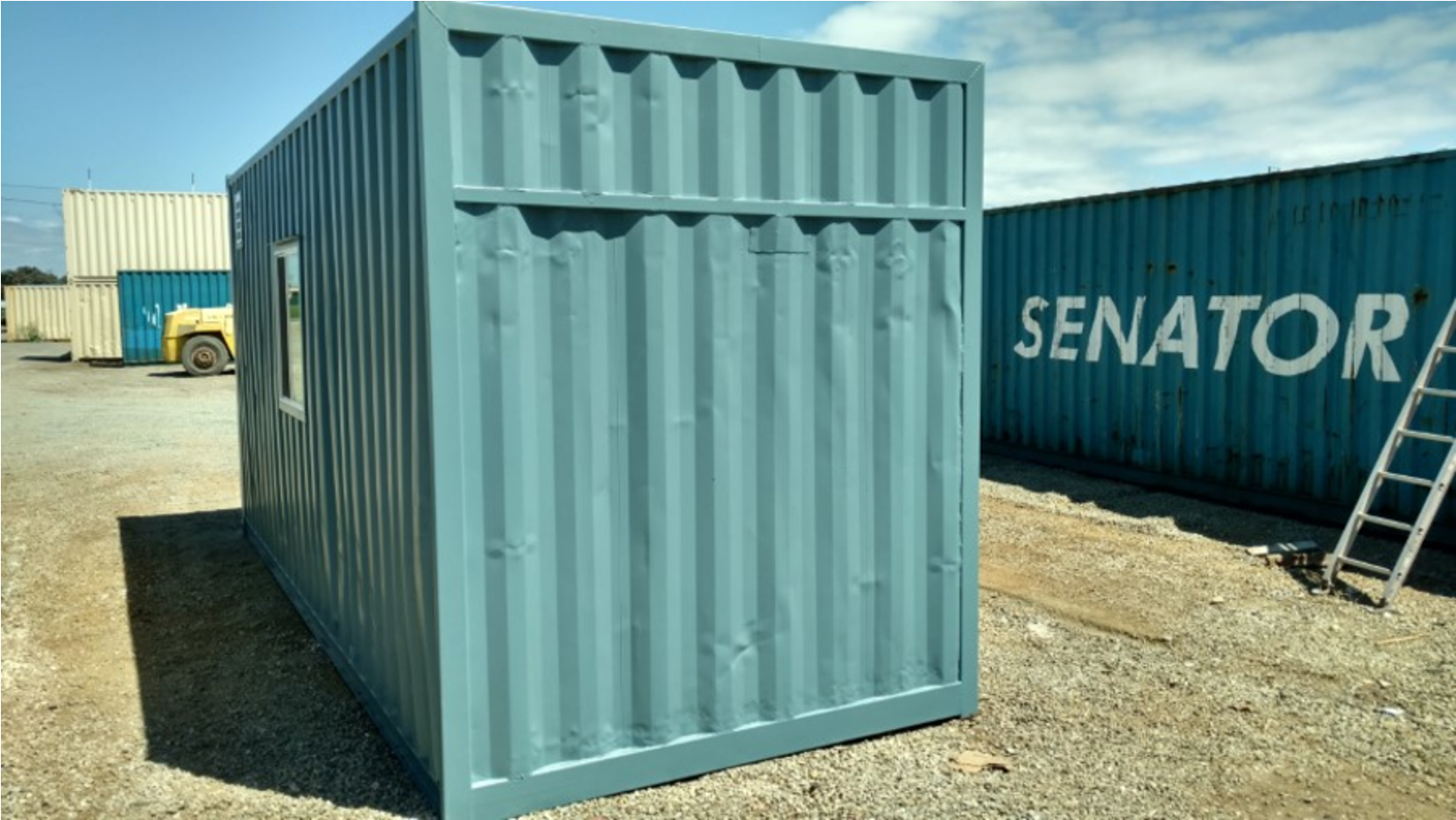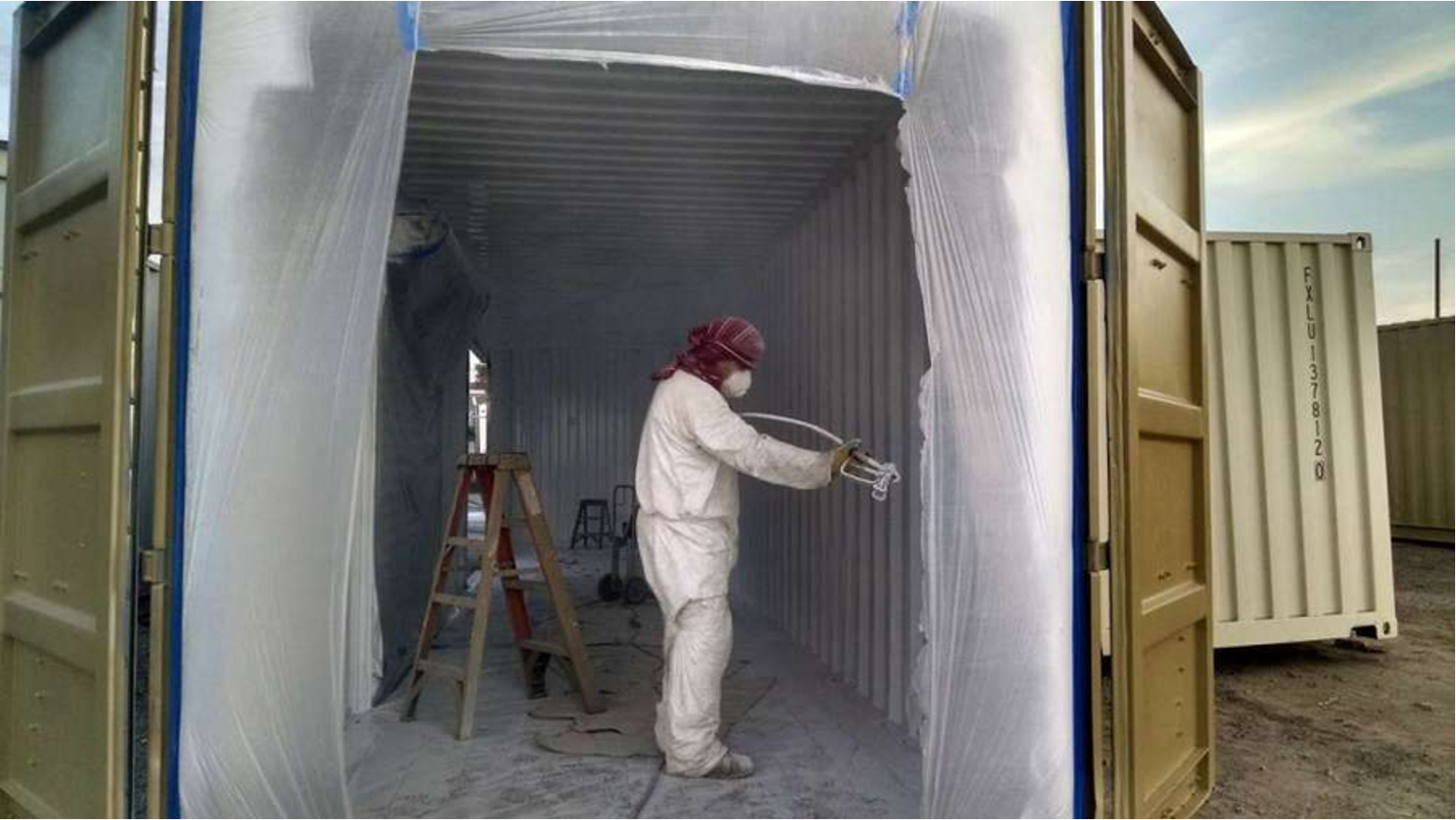How To Paint A Shipping Container
Get a quoteGuide to Painting Shipping Container
Key Takeaways
- Always clean and prepare the shipping container surface before painting for proper paint adhesion.
- Paint your container in mild weather to avoid paint bubbling or cracking.
- Applying a primer is important for a long-lasting paint job because it improves the adhesion of the paint to the container.
- Conexwest customization services cover the internal and external painting of shipping containers.
Steps To Paint A Shipping Container
1. Planning and Preparation
Begin by inspecting the container for any signs of wear, rust, or damage. Remove any dirt, grime, or loose paint using a pressure washer or scrub brush with a mild detergent. Allow the container to dry before moving on to the next step.
2. Surface Inspection and Repair
Once the container is clean, inspect its surfaces. Look for rust spots, dents, or areas with flaking paint. Use a wire brush or sandpaper to remove rust and smooth out any imperfections. If you find significant rust or damage, consider applying a rust converter or filler for deeper repairs.
3. Choosing the Right Paint
Choosing the right type of paint will give your container a long-lasting finish. Use high-quality marine-grade or industrial-grade paint designed for metal surfaces. These paints have excellent adhesion and weather resistance.
4. Primer Application
Applying a primer is an essential step that promotes better adhesion of the paint to the metal surface. Use a primer suitable for metal containers and apply it evenly using a brush, roller, or spray gun. Follow manufacturer guidelines about application thickness and drying time.
5. Painting
After the primer has dried, it’s time to apply the paint. Stir the paint thoroughly for consistency and use a paint sprayer for the best coverage on large surfaces. Start from the top of the container and work your way down to avoid drips and uneven application.
For optimal results, apply multiple thin coats of paint, allowing each coat to dry fully before adding another layer.
6. Finishing Touches
Once you’ve applied the final coat of paint and it has dried completely, inspect the container for any imperfections or areas needing touch-ups. Use a small brush to detail the corners or seams. Consider applying a clear coat or sealant over the painted surface once you are satisfied with the finish.
Conexwest, a leader in shipping and storage solutions based in Northern California, offers new, used, and refurbished containers from 10ft to 45ft, with fast delivery within 3-7 days and container fabrication options like adding shelves and locks. We serve over 10,000 customers nationwide, including prestigious clients like the U.S. Navy and Google. As an ISO 9001 and AWS-certified company, we ensure top quality and competitive pricing. |
Choosing The Right Paint For Shipping Containers

Choose the right type of paint for your shipping container—industrial-grade or marine-grade paint provides the best protection against the elements.
1. Environment and Exposure
- Climate Conditions: Assess the climate where the container will be located. For hot and humid environments, select paints that can withstand moisture and UV exposure. In coastal areas, use marine-grade paints with anti-corrosive properties to withstand seawater.
- UV Resistance: If the container is to be in direct sunlight, use UV-resistant paints to prevent fading and deterioration.
2. Types of Paint:
- Marine-Grade Paints: These paints contain additives like zinc chromate for corrosion resistance and can withstand saltwater, UV rays, and humidity.
- Acrylic Paints: Water-based acrylic paints are popular for their ease of application and lower VOC emissions. They provide a good finish and can last several years.
- Epoxy Paints: Epoxy paints form a hard, durable coating that can last 10-15 years with strong adhesion and chemical resistance. They are ideal for industrial uses and must be prepared carefully because of their complex mixing process.
- Polyurethane Paints: These paints are durable and protect your container against weather damage. They can release hazardous fumes and are typically reserved for industrial and heavy-duty projects.
3. Paint Standards
- The C3 standard is suitable for general marine environments, while C5 is necessary for highly corrosive environments. The minimum paint thickness should be 75μm for C3 and 150μm for C5.
Maintenance Tips To Prolong Paint Life
- Regular Cleaning: Clean the container every few months using water and a mild soap solution to remove dirt, grime, and salt deposits.
- Inspect for Damage: Conduct bi-annual inspections to identify scratches, chips, or rust spots early before they worsen.
- Prompt Touch-Ups: Fix any scratches or chips immediately by sanding the area and applying touch-up paint to prevent rust formation.
- Reapply Protective Coatings: Consider applying a clear protective coating or sealant over the paint every few years to improve surface durability and protect against UV rays and moisture.
- Avoid Harsh Chemicals: Clean with gentle solutions. Avoid abrasive cleaners that can damage the paint finish.
- Monitor Environmental Conditions: Be mindful of humidity and temperature when performing maintenance.
- Store Properly: If possible, store the container in a shaded or covered area to protect it from direct sunlight, rain, snow, or sleet.
- Ventilate During Interior Painting: Maintain proper ventilation when painting the inside of the container to prevent the buildup of toxic fumes.
How Conexwest Can Help You Paint Shipping Containers

Conexwest experts know how to paint shipping containers for a long-lasting finish
While painting a shipping container can be a fulfilling DIY project, professional help is the way to go for the best results. At Conexwest, our fabrication service covers painting. Here’s how we can help you:
- Exterior and Interior Painting: We offer specialized painting services for the interiors and exteriors of shipping containers. Our team uses high-quality marine-grade paints that can withstand harsh weather, so your container looks great and remains protected from rust and corrosion.
- Customization Options: With us, you can choose from a wide range of colors and finishes to match your style or branding.
- Professional Preparation: Before we start painting, we make sure that the surface of your container is properly prepared for a smooth, long-lasting finish. This includes cleaning, sanding, and applying primer if necessary.
- Quality Assurance: Our team complies with stringent safety and quality control guidelines so that every job meets our high standards.
- Quick Turnaround: We strive to complete our painting projects efficiently without compromising quality so you can start using your container as quickly as possible.
Frequently Asked Questions (FAQs)
- Why should I paint my shipping container?
Painting your shipping container serves multiple purposes: it improves its visual appeal and allows you to customize its appearance to match your style or branding. Additionally, paint acts as a protective barrier against moisture, UV rays, and corrosion and significantly extends the operating life of the container.
- How long does shipping container paint last?
The longevity of shipping container paint depends on several factors, including the type of paint used, environmental conditions, and maintenance regimen. With proper care, a high-quality paint job can last anywhere from 5 to 10 years. Regular cleaning, touch-ups, and protective sealants can help extend the lifespan of the paint.
- What tools are needed to paint a container?
To paint a shipping container, you'll need the following tools and materials:
- Paint sprayer or roller
- Wire brush or sandpaper for surface preparation
- Primer and paint (waterborne or alkyd enamel)
- Rust converter (if needed)
- Protective gear, such as gloves and goggles
- Drop cloths or tarps to protect the surrounding area
- Can I change the color of my container later?
Yes, you can change the color of your shipping container at any time. However, it's important to follow the proper steps so the new paint adheres well and provides lasting results. This includes cleaning the surface, applying a primer, and using high-quality paint. Keep in mind that changing from a dark to a light color may require additional coats to achieve full coverage.
- What services does Conexwest provide?
We specialize in selling, modifying, and renting high-quality shipping containers. Our offerings include certified new containers, used containers, refurbished containers, custom modifications (such as adding windows or doors), and specialized containers like refrigerated units. We also provide delivery services.
